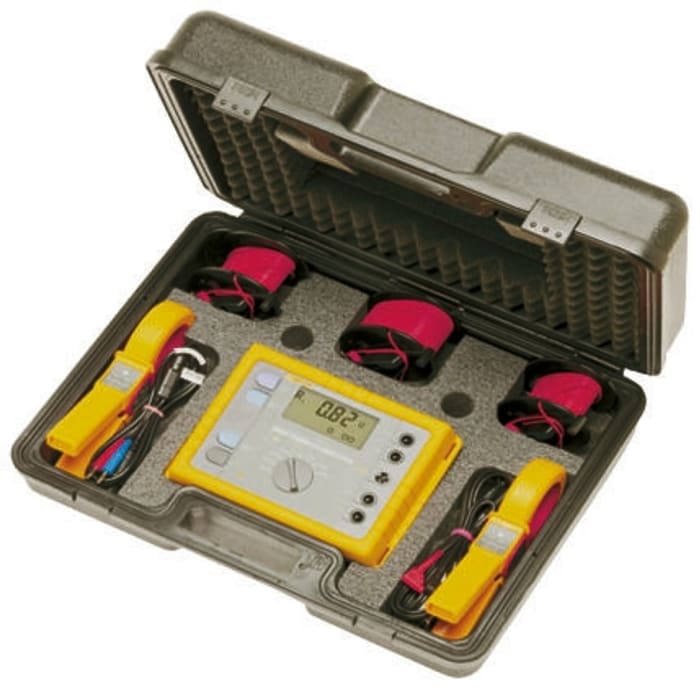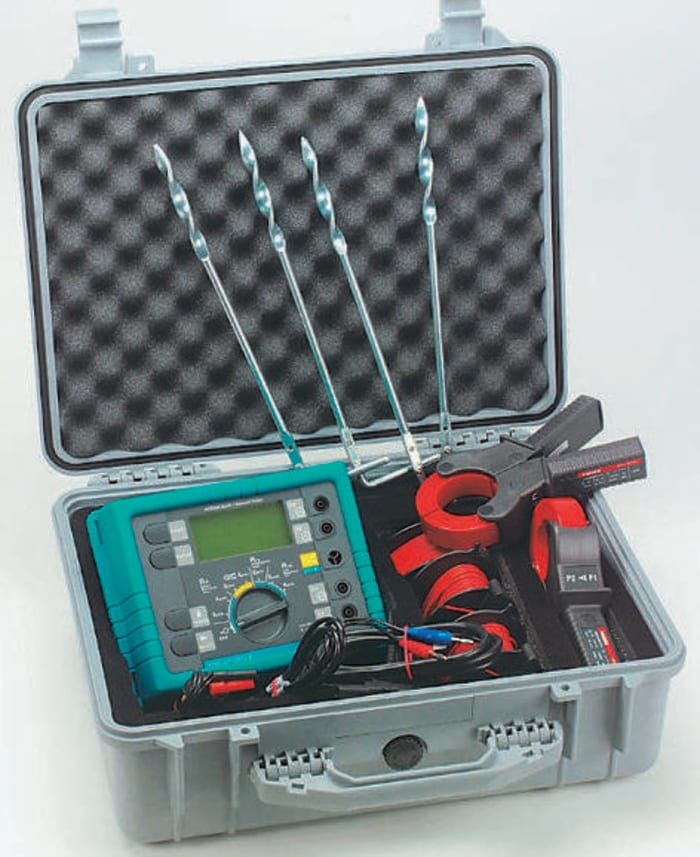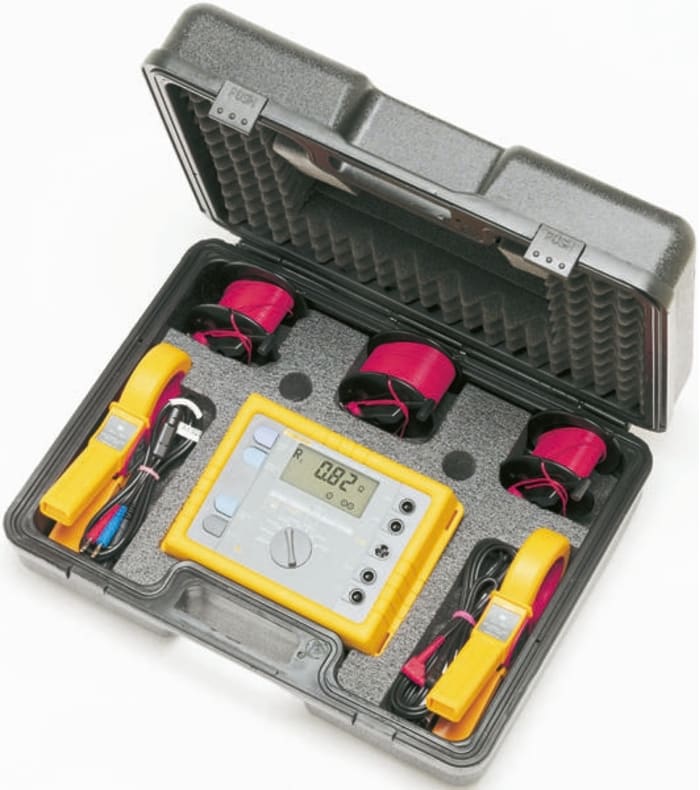Technical documents
Specifications
Brand
FlukeIncludes
Batteries, Cable Reel x 3, Carrying Case, Earth Ground Stake x 4, Fluke 1625 Tester, Inducing Clamp, Sensing Clamp, Test Lead x 2, User Manual
Country of Origin
Romania
Product details
Fluke 1625-2 GEO Earth Ground Tester Kit
Offering data storage and download capabilities via a USB port, the Fluke 1625-2 can perform 4 types of earth ground measurement. This tester is able to measure ground loop resistance using only clamps, this method doesn't require the use of earth ground stakes or disconnection of ground rods. Making this distinctive tester easy to use and an ideal addition to any engineers testing kit.
Features and Benefits:
• 3- and 4-pole Fall-of-Potential, earth resistance loop testing
• 4-pole Soil Resistivity testing
• Selective earth ground rod testing using 1 clamp
• Stakeless earth ground rod testing using 2 clamps
• IP56 rated for outdoor use
• Rugged carrying case
• USB data storage and transfer
• Automatic Frequency Control (AFC), identifies existing interference and chooses a measurement frequency to minimize its effect, providing more accurate earth ground value
• R* measurement, calculates earth ground impedance at 55 Hz to more accurately reflect the earth ground resistance that a fault-to earth ground would see
• Adjustable limits for quicker testing
How do earth and ground testers work?
A ground or earth is a conducting connection, usually between an electrical circuit and the earth. Earth grounding is a connection from a circuit conductor, usually the neutral, to a ground electrode or plate placed in the earth. Equipment grounding ensures that operating equipment or a circuit is grounded properly. This prevents differences in voltage potential from a possible flash-over from things such as lightning strikes by ensuring the current finds a safe path to the earth.
A ground resistance tester is able to take resistance measurements using several test methods, selective testing, stake-less testing, 2-pole testing and 3-4-pole testing. They are able to test the resistance between the earth plate or earth electrode and surrounding ground. In pole testing probes are entered in to the ground and a reading is taken at each location. Readings are then plotted against the distances, the point where the resistance drops is the approximate resistance of the grounding. This is called the fall of potential method and is highly reliable.
Supplied with
6 x AA LR6 batteries, 6 x test leads, 4 x earth ground stakes, 3 x cable reels with wire (2 x 25 m, 1 x 50 m), 2 x clamps (one inducing, one sensing), users manual, carrying case.
Stock information temporarily unavailable.
€ 7,598.66
€ 7,598.66 Each (ex VAT)
Calibration type
No Calibration
1
€ 7,598.66
€ 7,598.66 Each (ex VAT)
Stock information temporarily unavailable.
Calibration type
No Calibration
1
Technical documents
Specifications
Brand
FlukeIncludes
Batteries, Cable Reel x 3, Carrying Case, Earth Ground Stake x 4, Fluke 1625 Tester, Inducing Clamp, Sensing Clamp, Test Lead x 2, User Manual
Country of Origin
Romania
Product details
Fluke 1625-2 GEO Earth Ground Tester Kit
Offering data storage and download capabilities via a USB port, the Fluke 1625-2 can perform 4 types of earth ground measurement. This tester is able to measure ground loop resistance using only clamps, this method doesn't require the use of earth ground stakes or disconnection of ground rods. Making this distinctive tester easy to use and an ideal addition to any engineers testing kit.
Features and Benefits:
• 3- and 4-pole Fall-of-Potential, earth resistance loop testing
• 4-pole Soil Resistivity testing
• Selective earth ground rod testing using 1 clamp
• Stakeless earth ground rod testing using 2 clamps
• IP56 rated for outdoor use
• Rugged carrying case
• USB data storage and transfer
• Automatic Frequency Control (AFC), identifies existing interference and chooses a measurement frequency to minimize its effect, providing more accurate earth ground value
• R* measurement, calculates earth ground impedance at 55 Hz to more accurately reflect the earth ground resistance that a fault-to earth ground would see
• Adjustable limits for quicker testing
How do earth and ground testers work?
A ground or earth is a conducting connection, usually between an electrical circuit and the earth. Earth grounding is a connection from a circuit conductor, usually the neutral, to a ground electrode or plate placed in the earth. Equipment grounding ensures that operating equipment or a circuit is grounded properly. This prevents differences in voltage potential from a possible flash-over from things such as lightning strikes by ensuring the current finds a safe path to the earth.
A ground resistance tester is able to take resistance measurements using several test methods, selective testing, stake-less testing, 2-pole testing and 3-4-pole testing. They are able to test the resistance between the earth plate or earth electrode and surrounding ground. In pole testing probes are entered in to the ground and a reading is taken at each location. Readings are then plotted against the distances, the point where the resistance drops is the approximate resistance of the grounding. This is called the fall of potential method and is highly reliable.
Supplied with
6 x AA LR6 batteries, 6 x test leads, 4 x earth ground stakes, 3 x cable reels with wire (2 x 25 m, 1 x 50 m), 2 x clamps (one inducing, one sensing), users manual, carrying case.



